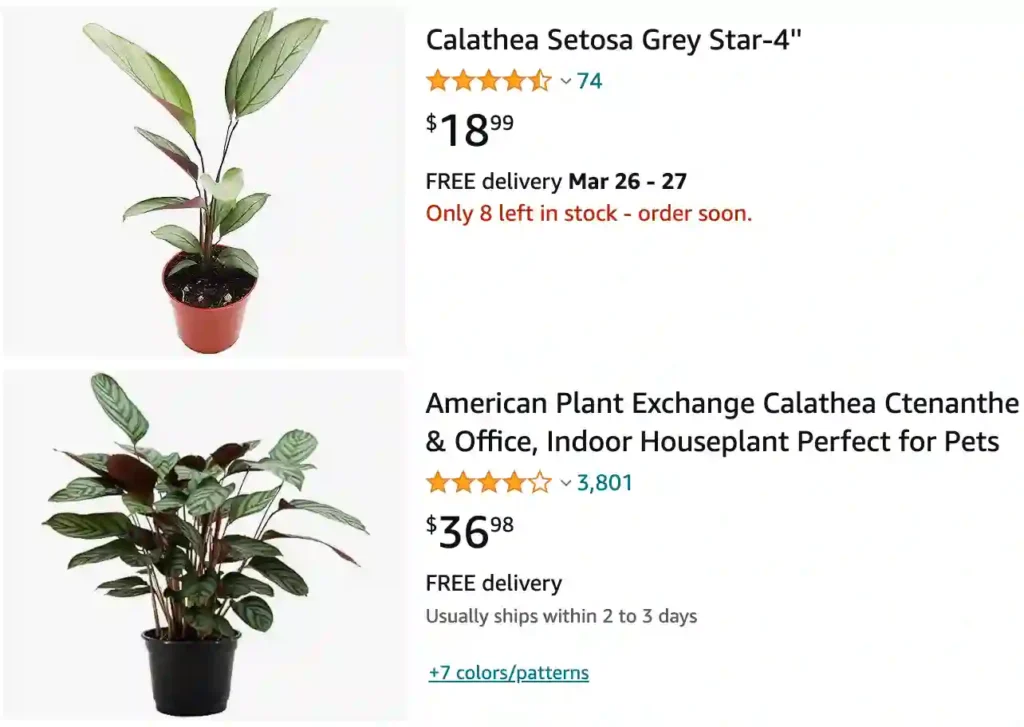
Ctenanthe setosa vs calathea
I’ve found that Ctenanthe setosa is easier to care for compared to Calathea, as it handles inconsistent watering better. The foliage of Ctenanthe setosa is less prone to browning edges, which I appreciate in my low-humidity environment. Calathea, on the other hand, has stunningly vibrant leaves that draw more attention and add a tropical feel to my living space. Despite the extra care Calathea requires, its intricate leaf patterns and colors make it a showstopper in my plant collection. When I want a lower-maintenance plant that still offers visual appeal, I reach for Ctenanthe setosa.
15 Species in Genus Ctenanthe
How to propagate Ctenanthe setosa?
Ctenanthe setosa, the Fishbone Prayer Plant, can be propagated in two main ways: stem cuttings and division. Here’s a breakdown of both methods:
Propagation by Stem Cuttings:
- Select a Healthy Stem: Choose a healthy stem with at least 4 leaves. Ideally, it should be around 5 inches long.
- Prepare the Cutting: Using sterilized pruners, make a clean cut just below a leaf node (the bump where a leaf joins the stem). Remove the lower leaves, leaving only the top 2-3 leaves.
- Rooting the Cutting: There are two options:
- Water Propagation: Place the stem in a jar filled with fresh, lukewarm water. Ensure at least one node is submerged. Change the water every few days to prevent bacteria growth. Once roots reach about an inch long, plant the cutting in a pot with well-draining potting mix.
- Soil Propagation: Dip the cut end of the stem in rooting hormone (optional) and plant it directly in a pot with well-draining potting mix. Water lightly and keep the soil consistently moist but not soggy.
- Aftercare: Whichever method you choose, place the pot in a warm location with bright, indirect light. Cover the pot loosely with a plastic bag to maintain humidity (optional). Mist the leaves regularly and remove the plastic bag once new growth appears.
Propagation by Division:
- Unpot the Plant: Carefully remove your Ctenanthe setosa from its pot. Gently loosen the soil around the roots.
- Division: Identify natural separations between the plant’s growths, each with its own roots. Carefully separate these divisions using your hands or sterilized pruners.
- Potting: Plant each division in its own pot with well-draining potting mix. Water thoroughly and continue caring for them as you would a mature Ctenanthe setosa.
General Tips:
- Propagate your Ctenanthe setosa during the spring or summer growing season for best results.
- Maintain consistent warmth and humidity around the propagating plantlets.
- Be patient! It can take several weeks for roots to develop on stem cuttings.
Is Ctenanthe setosa toxic to cats?
When it comes to my cats, I always want to be cautious about the plants I keep at home. Thankfully, Ctenanthe setosa is non-toxic to cats. Knowing this gives me peace of mind because my curious felines love to explore and sometimes nibble on the leaves. I still keep an eye on them to make sure they don’t overindulge, but it’s reassuring to know that this beautiful plant is safe for them.
How to care for Ctenanthe setosa?
Here’s how to care for your Ctenanthe setosa:
Light:
- Provide bright, indirect light. Avoid harsh direct sun, which can scorch the leaves.
- If the leaves lose their variegation and turn greener, it might be getting insufficient light.
Water:
- Maintain consistently moist soil, but avoid waterlogging. Let the top inch of soil dry out slightly before watering again.
- Use lukewarm water for watering.
- In winter, reduce watering frequency as the plant goes dormant.
Humidity:
- Ctenanthe setosa thrives in high humidity. Mist the leaves regularly, especially indoors with dry air.
- Alternatively, you can use a pebble tray filled with water or a humidifier to increase ambient humidity.
Temperature:
- Ideal temperatures are between 60-80 degrees Fahrenheit (15-27 degrees Celsius).
- Protect the plant from cold drafts and sudden temperature fluctuations.
Fertilizing:
- During the growing season (spring and summer), fertilize monthly with a diluted liquid fertilizer for indoor plants.
- You can stop fertilizing during winter.
Soil and Potting:
- Use a well-draining potting mix. A mixture of potting soil, perlite, and orchid bark can be a good option.
- Ensure the pot has drainage holes to prevent root rot.
Repotting:
- Repot your Ctenanthe setosa every 1-2 years or when the roots outgrow the pot.
Additional Tips:
- Wipe down the leaves occasionally with a damp cloth to remove dust and improve aesthetics.
- Ctenanthe setosa is generally pest and disease resistant, but watch out for mealybugs and scale insects.
- You can propagate your Ctenanthe setosa by stem or division during the growing season.
Is Ctenanthe setosa toxic to dogs?
I’m relieved to know that Ctenanthe setosa isn’t toxic to dogs, just like with my cats. Even though my dogs are less likely to chew on houseplants, it’s comforting to know they’re safe if they do decide to take a nibble. Having pet-friendly plants like this makes it easier to enjoy a lush, green home without constantly worrying about potential hazards to my furry friends.
If i die, water my plants!



